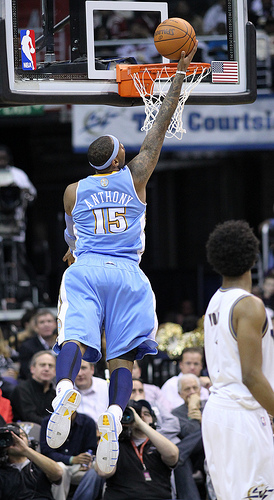Don’t Be Deceived by Carmelo Anthony’s Scoring Totals
Here is how the Associated Press led the story describing the Miami Heat’s elimination of the New York Knicks in the 2012 NBA Playoffs:
The final horn sounded, and LeBron James wrapped his arms around Carmelo Anthony in a warm embrace.
Their head-to-head scoring matchup in this series was even, 139 points apiece.
Just about everything else tipped Miami’s way — so the Heat are moving on and the New York Knicks are going home.
Such a lead gives the impression that Carmelo Anthony and LeBron James played about the same in this series. If we delve a bit deeper, though, we see that the scoring totals are quite deceptive. Here is each player’s level of shooting efficiency in the series:
Carmelo Anthony: 0.435 Effective Field Goal Percentage, 0.489 True Shooting Percentage
LeBron James: 0.517 Effective Field Goal Percentage, 0.604 True Shooting Percentage
Because Melo was a far less efficient scorer, he had to attempt 34 more shots from the field than LeBron in the series. And because shot attempts are a finite resource, this means that other players on the Knicks had to attempt fewer shots (with the exception of J.R. Smith, everyone else on the Knicks who attempted at least 10 shots from the field was more efficient than Melo in this series).
In contrast, LeBron was able to achieve his scoring total with fewer shots, giving him more opportunities to set up his teammates. One can see this clearly when we look at assists. LeBron finished the series with 28 assists while Melo only had 11.
Melo did finish with more rebounds and fewer turnovers. But when we consider the vast differences in shooting efficiency and assists we see that King James – as has been the case throughout each player’s respective careers – had a far bigger impact on his team’s fortunes. In fact, Andres Alvarez – at the Wages of Wins Journal – notes that LeBron led the Heat in Wins Produced during this series (he did the same for the regular season). In contrast, Melo’s production of wins – because he was a very inefficient scorer – was in the negative range.
Such a story highlights an important lesson: scoring totals in the NBA can be quite deceptive. A player can boost his scoring totals by simply taking more and more shots. But if this shooting is inefficient, teams actually suffer from this choice. Of course, as the AP story illustrates, the inefficient scorer’s reputation often does not decline from this choice. Hence we see this story repeat itself over and over again in the NBA.


Comments